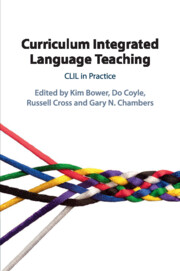Book contents
- Curriculum Integrated Language Teaching
- Curriculum Integrated Language Teaching
- Copyright page
- Contents
- Figures
- Tables
- Contributors
- Foreword
- Preface
- Acknowledgements
- Part I The Educational Context for CLIL
- Part II Current Aspects of Practice in CLIL
- 4 What Pupils Say about Transition (KS2–3) and What This Might Mean for CLIL
- 5 Diversity and Transnationalism
- 6 Three Schools, Three Models
- 7 Plurilingualism in the Content and Language Integrated Classroom
- Part III New Knowledge and Future Directions
- Afterword
- Index
- References
5 - Diversity and Transnationalism
The ‘Merged Curriculum’ Approach in Bilingual Programmes in Australia
from Part II - Current Aspects of Practice in CLIL
Published online by Cambridge University Press: 27 July 2020
- Curriculum Integrated Language Teaching
- Curriculum Integrated Language Teaching
- Copyright page
- Contents
- Figures
- Tables
- Contributors
- Foreword
- Preface
- Acknowledgements
- Part I The Educational Context for CLIL
- Part II Current Aspects of Practice in CLIL
- 4 What Pupils Say about Transition (KS2–3) and What This Might Mean for CLIL
- 5 Diversity and Transnationalism
- 6 Three Schools, Three Models
- 7 Plurilingualism in the Content and Language Integrated Classroom
- Part III New Knowledge and Future Directions
- Afterword
- Index
- References
Summary
This chapter highlights an innovative approach to bilingual school programmes in government schools in Australia. The phenomenon, which can be described as merged or harmonized curriculum, integrates the national curriculum requirements of two countries. Formal merged curricula are usually underpinned by an official bilateral government agreement. Informal merged curricula can take different forms depending on the contexts and people involved; the example used here describes how teachers at a school with a Japanese bilingual programme use aspects of maths curriculum and pedagogy drawn from Australia and Japan. The chapter introduces examples of formal and informal merged curricula in two schools and analyses them from a theoretical perspective based on the 4Cs Framework, the Language Triptych and the seven principles as outlined in Chapter 1 (Coyle, 2007). This study highlights one of the 4Cs – culture – but understands that all 4Cs are interconnected. Merged curricula provide a useful lens to analyse cultural implications of bilingual education.
- Type
- Chapter
- Information
- Curriculum Integrated Language TeachingCLIL in Practice, pp. 93 - 106Publisher: Cambridge University PressPrint publication year: 2020
References
- 1
- Cited by



